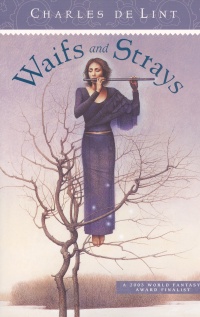| ________________
CM . . .
. Volume XI Number 8 . . . . December 10, 2004
excerpts: "There are no happy endings," Cerin told her. "There are no real endings ever happy or otherwise. We all have our own stories which are just a part of the one Story that binds both this world and Faerie. Sometimes we step into each other's stories perhaps just for a few minutes, perhaps for years and then we step out of them again. But all the while, the Story just goes on." That day, his explanation only served to confuse her. ("Ghosts of Wind and Shadow," p. 309) "Then what does it have to do with? Angel wants to know. It's a reasonable request more so because I'm the one who's come to her, taking up her time. I know what I want to say, but I don't know how to phrase it. My new life's like a dress I might have wished for in a store window, saved for, finally bought, only to find out that while it's the right size, it still doesn't quite fit right. It's the wrong color. The sleeves are too long, or maybe too short. The skirt's too tight. It's not something Angel would understand. Intellectually, maybe, but not how I feel about it. Angel's one of those people who sees everyone having a purpose in life, you've just got to figure out what it is. I don't even know where to begin figuring out that kind of stuff. ("Waifs and Strays," p. 330) This collection of 16 stories, unified by the theme of having young adult protagonists, is a progressive journey through de Lint's short stories and writing history. He prefaces each of the five sections with a background note about his writing focus at the time, and each story with concise information about that story, his creative muse and his characters. His writing style has a strong oral component to it, and much of the internal dialogue is directly focused at the reader. None of these stories were originally written for the young adult reader, but, as this collection so aptly demonstrates, de Lint's perceptive awareness of that age group and their angst and search for identity, makes them extremely accessible and relevant. Female protagonists are the norm in this collection, and indeed, in much of de Lint's other work as well as rebels and loners. As Terri Windling, in the preface, states, "A Charles de Lint story usually concerns the 'outsiders' of modern society: punks, street people, runaway children, mystics, misfits, and eccentrics of all sorts, whose lives are touched, illuminated, and changed by a glimpse of Mystery." It is the mystery of the land of faerie and its connections to our landscape and its people that infuse these tales with power. His stories are also populated with references to contemporary novels, folklore, music and songs. The stories contained in the first two sections, "Tamson House" and "Ottawa and the Valley," are set in contemporary Ottawa, the setting of many of de Lint's earlier works. The third and forth sections are of stories set either in the otherworld, the land of dream or in Bordertown which exists on the cusp of this world and the other. The stories in the final section are set in Newford, the city de Lint created for his characters once he left the concrete mapping of the streets of Ottawa. Readers of de Lint's later work know the city of Newford and the intertwining characters that populate the city and his writing. One of my favourite tales in this collection, and I have many, is "May This Be Your Last Sorrow," originally published in 1998 in The Essential Bordertown, a collection of stories about this community by a variety of fantasy writers. de Lint says of this story: You've probably noticed by now that many of my characters have less than happy childhoods. Some of us are born lucky, born into families that love and care for us, and some of us aren't. It seems to me that the lucky ones, and those who manage to survive their private terror times, owe it to the less fortunate to do what we can to help them, even if it's only keeping a dialogue open about what goes on behind too many locked doors. We need to be there for them, to give them comfort and respect, and to listen to their stories. And if they can't tell their own stories, then we need to tell their stories for them. Here, de Lint's nameless female narrator is telling her story to a gargoyle, the only thing she feels will understand her. And funnily enough, the gargoyle really does! Highly Recommended. Gail de Vos In addition to being a professional storyteller and author or co-author of seven books related to storytelling, Gail de Vos is also an instructor in the School of Library and Information Science at the University of Alberta in Edmonton, AB.
To comment
on this title or this review, send mail to cm@umanitoba.ca.
Copyright © the Manitoba Library Association. Reproduction for personal
use is permitted only if this copyright notice is maintained. Any
other reproduction is prohibited without permission.
NEXT REVIEW |TABLE OF CONTENTS FOR THIS ISSUE
- December 10, 2004.
AUTHORS
| TITLES | MEDIA REVIEWS
| PROFILES
| BACK ISSUES
| SEARCH | CMARCHIVE
| HOME |
